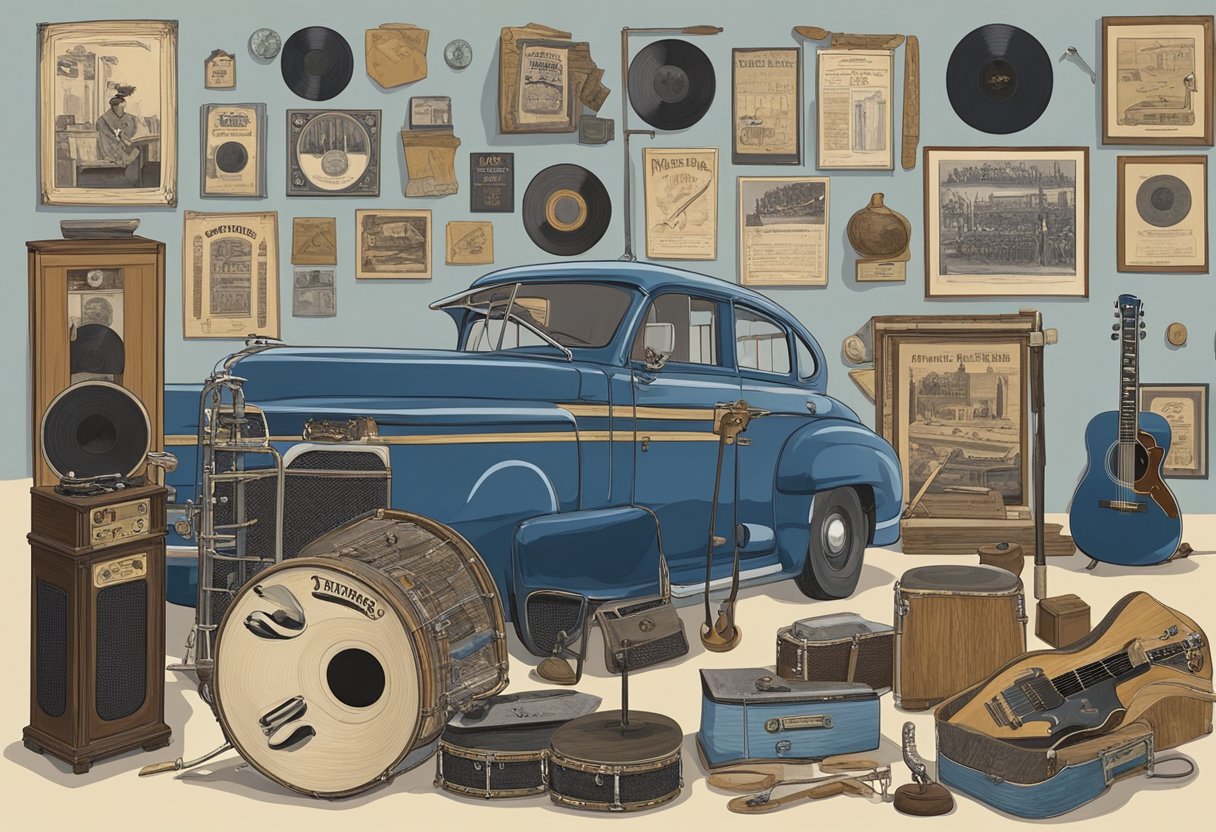Types Of Blues
Blues is a genre of music that originated in the African American community in the early 20th century. It has since evolved into a diverse range of styles and subgenres that continue to influence modern music to this day. From acoustic to electric, from Delta to Chicago, there are many different types of blues music that offer a unique listening experience.
The historical roots of blues can be traced back to the work songs and spirituals of enslaved Africans in the United States. The genre has since evolved to encompass a wide range of themes and emotions, from heartbreak and despair to joy and celebration. Blues music has also been a powerful tool for social commentary, with many artists using their music to address issues of race, poverty, and inequality.
Key Takeaways
- Blues is a diverse genre of music that originated in the African American community in the early 20th century.
- The historical roots of blues can be traced back to the work songs and spirituals of enslaved Africans in the United States.
- Blues music has evolved to encompass a wide range of styles and subgenres, and has been a powerful tool for social commentary.
Historical Roots of Blues

Blues music has a rich and complex history that has evolved over time, influenced by various musical traditions and cultural contexts. Two major historical roots of blues music are the African American influence and the evolution of work songs and spirituals.
African American Influence
Blues music has its roots in the African American communities of the South, particularly in the Mississippi Delta region. The musical traditions of West Africa were brought to America by enslaved Africans, and these traditions became an important part of the cultural heritage of African Americans.
African American musical traditions were characterized by a strong emphasis on rhythm and percussion, and often involved call-and-response patterns. Field hollers, work songs, and spirituals were all important forms of African American music that helped to shape the development of blues music.
Evolution from Work Songs and Spirituals
Blues music evolved from the work songs and spirituals that were sung by African Americans in the South. Work songs were sung by laborers, often while they were working in the fields or on other manual labor tasks. These songs were often rhythmic and repetitive, with call-and-response patterns that helped to keep the workers in sync.
Spirituals were religious songs that were sung by African Americans in the South. These songs often had a deeply emotional and spiritual quality, and were used to express feelings of hope, faith, and perseverance in the face of adversity.
Over time, the musical traditions of work songs and spirituals began to merge, and a new form of music emerged that came to be known as blues music. Blues music was characterized by its use of the 12-bar blues form, which featured a specific chord progression and a distinctive rhythm.
In conclusion, the historical roots of blues music are deeply intertwined with the cultural traditions of African Americans in the South. The evolution of work songs and spirituals played a crucial role in the development of blues music, and these traditions continue to influence the genre to this day.
Blues Styles and Subgenres
Blues music has evolved and diversified over the years, giving rise to various styles and subgenres. Here are some of the most notable ones:
Delta Blues
Delta blues originated in the Mississippi Delta region, and is characterized by its raw, stripped-down sound. It typically features a solo male vocalist accompanied by a slide guitar or harmonica. The lyrics often deal with themes of poverty, oppression, and heartbreak.
Chicago Blues
Chicago blues emerged in the 1940s and 1950s as African Americans migrated from the South to the industrial North. It is characterized by its amplified sound, featuring electric guitars, bass, drums, and sometimes horns. Chicago blues is often associated with artists such as Muddy Waters, Howlin’ Wolf, and Willie Dixon.
Texas Blues
Texas blues is a style that originated in the Lone Star State, and is characterized by its heavy use of guitar. It often features a fast, energetic rhythm and a driving beat. Artists such as Stevie Ray Vaughan and T-Bone Walker are often associated with this style.
Piedmont Blues
Piedmont blues is a style that originated in the Southeastern United States, and is characterized by its fingerpicking style. It often features a ragtime-influenced rhythm and a more melodic sound than other blues styles. Artists such as Blind Boy Fuller and Reverend Gary Davis are often associated with this style.
Overall, blues music has given rise to a wide range of subgenres, each with its own unique characteristics and influences. From classic female blues to contemporary blues rock, there’s something for everyone in the world of blues.
Influential Blues Artists
Blues music has been around for over a century and has been shaped by many talented musicians. The following are some of the most influential blues artists of all time.
Pioneers of Blues
Charley Patton, Blind Lemon Jefferson, and Son House are considered pioneers of blues music. They were among the first to record blues songs and their music heavily influenced future blues musicians. Patton was known for his unique guitar playing style and powerful voice. Jefferson was a talented guitarist and singer who wrote many popular blues songs. Son House was a master of the bottleneck slide guitar and his music was known for its emotional intensity.
Blues Guitar Legends
Muddy Waters, B.B. King, and John Lee Hooker are some of the most famous blues guitarists of all time. Muddy Waters was known for his powerful voice and innovative guitar playing style. B.B. King was a master of the blues guitar and his signature vibrato is still imitated by guitarists today. John Lee Hooker was known for his unique guitar playing style and his ability to create a powerful groove.
Iconic Blues Vocalists
Bessie Smith, Ma Rainey, and Blind Willie Johnson were some of the most iconic blues vocalists of all time. Bessie Smith was known for her powerful voice and her ability to convey emotion through her music. Ma Rainey was a pioneer of blues music and was known for her powerful voice and commanding stage presence. Blind Willie Johnson was a talented guitarist and singer who wrote many popular blues songs.
Other notable blues musicians include T-Bone Walker, Chuck Berry, Professor Longhair, Dr. John, and Stevie Ray Vaughan. These musicians helped shape the blues genre and their contributions continue to influence musicians today.
Blues Music Instruments and Techniques
Blues music is known for its unique sound, which is created by using a variety of instruments and techniques. Here are some of the most common instruments and techniques used in blues music:
Guitar and Slide Techniques
The guitar is one of the most important instruments in blues music. It can be played in a number of ways, including fingerpicking, strumming, and using a slide. The slide is a metal or glass tube that is placed over the guitar strings to create a unique sound. It is often used to play the blues scale, which is a series of notes that are commonly used in blues music.
Harmonica and Piano Styles
The harmonica is another important instrument in blues music. It is often played in a style called “cross-harp,” which involves playing in a key that is different from the key of the harmonica. This technique creates a unique sound that is often associated with blues music.
The piano is also commonly used in blues music. It is often played in a style called “boogie-woogie,” which involves playing a repeating bass line with the left hand and improvising with the right hand.
Rhythm Section and Brass
The rhythm section is an important part of blues music. It typically includes drums, bass, and rhythm guitar. The drums provide the beat, while the bass and rhythm guitar create a foundation for the melody.
Brass instruments, such as the trumpet and saxophone, are also commonly used in blues music. They are often used to play solos and add a unique sound to the music.
Overall, blues music is known for its use of a variety of instruments and techniques. From the guitar and harmonica to the rhythm section and brass, each instrument plays an important role in creating the unique sound of blues music.
Blues Influence on Modern Music
Blues has had a significant impact on modern music, especially in genres such as rock, jazz, and rhythm and blues. This section will explore how blues has influenced these genres and how it has contributed to the evolution of popular music.
Blues and Rock Music
Blues played a crucial role in the development of rock music. The Rolling Stones, one of the most iconic rock bands of all time, were heavily influenced by blues music. They covered many blues songs, including “Little Red Rooster” and “Love in Vain,” and incorporated blues elements into their own music. The use of blues scales, guitar riffs, and lyrics about heartbreak and loss can be heard in many rock songs.
Blues Elements in Jazz and R&B
Blues has also had a significant impact on jazz and R&B. Jazz musicians often incorporate blues scales and chord progressions into their music, and many jazz standards are based on the blues. R&B, which evolved from blues and gospel music, also incorporates blues elements such as call-and-response vocals, soulful melodies, and lyrics about love and heartbreak.
In addition to these genres, blues has also influenced popular music, country music, and even funk. The use of boogie-woogie piano in blues music influenced the development of rock and roll, while the use of acoustic guitars in delta blues contributed to the development of contemporary R&B.
Overall, blues has had a lasting impact on modern music, and its influence can be heard in a variety of genres. Its soulful melodies, heartfelt lyrics, and unique chord progressions have contributed to the evolution of popular music and continue to inspire musicians today.


